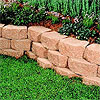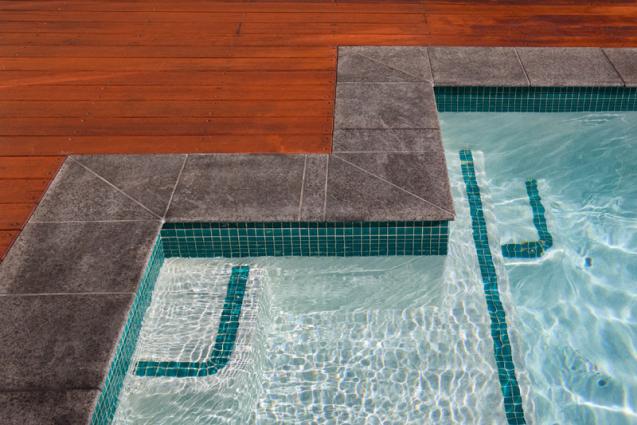
Things to consider when choosing Retaining Wall Product
By iPave|February 21, 2008
Retaining walls are a great way to add visual interest to a garden or to create separate levels on a sloping block in order to maximise your useable garden space.
A number of small walls can be used to create levels within a garden, give a decorative look or you may use a small retaining wall just to give your garden a formal edge. Retaining walls can also contain plants in their beds and keep bark and soil off your lovely paved areas.
One large retaining wall in a garden may help to create a large level area that can be used for more practical things like a grassy kid's area or a paved BBQ area. If you have any additional questions please do not hesitate to contact us, we are only too happy to help point you to the right product for your wall.
Considerations when choosing Retaining Wall product:
Dry Stack Retaining Walls vs. Mortar Walls Dry stack retaining wall product are blocks that can be laid together without the use of mortar (concrete) to bond the blocks together. They can be solid blocks or hollow blocks that require pins to interlock them together in a geometric formation. Dry stack walls will have limitations on size but are a great product for DIY projects.
Mortar products are very stable because they are wet bedded (concreted) down. They are usually a cheaper product by block but don't forget to incorporate the additional costs of concrete mix and render (you may not be saving money by using this option at all). Mortar products will also require more manual work to lay but will give a strong and stable result that will last a very long time. Some mortar products will also allow you to render mixing colours into the paint that you may not be able to achieve with a dry stack choice.
Whatever your choice, please don't hesitate in coming in and ask questions and view the different options available to you.
Capping and Corners Last and not least the finish of your new retaining wall may require a cap (top). Capping refers to the top layer of your wall. Some products have a finished capping block which should be laid as the top block on your wall but others require a paver like block to finish your wall. We will be happy to show you what caps are available with your retaining wall selection to give that fabulous finish on your wall.
If you also need corners for walls that need to run at 90 degree angles, please ask what is available because not all products have corner blocks and you may need to look at your selection or options.
I hope you have found this article useful. If you still have any questions, please don't hesitate in contacting us via phone or email.
Happy landscaping!
Simons Seconds
A number of small walls can be used to create levels within a garden, give a decorative look or you may use a small retaining wall just to give your garden a formal edge. Retaining walls can also contain plants in their beds and keep bark and soil off your lovely paved areas.
One large retaining wall in a garden may help to create a large level area that can be used for more practical things like a grassy kid's area or a paved BBQ area. If you have any additional questions please do not hesitate to contact us, we are only too happy to help point you to the right product for your wall.
Considerations when choosing Retaining Wall product:
- How high does your retaining wall need to be? This will determine what products are suitable.
- Do you need council approval for this wall height? If your wall is over 900mm (3 feet) you may need to check with your local council on building permits.
- Will your wall be straight or curved? There are products that are suitable for both but some products are only suitable for straight walls.
- Will you be building the wall yourself or will a professional be doing it? If you are doing it yourself you will want an easy alternative and may opt for a dry stack product.
- Do you have a colour preference? Not all products come in a range of colours but some do.
- Is the wall for structure or decorative purposes? Some walls are stronger and you may need to mortar (wet bed or concrete it in) for strength and stability.
- Do you have a budget?
Dry Stack Retaining Walls vs. Mortar Walls Dry stack retaining wall product are blocks that can be laid together without the use of mortar (concrete) to bond the blocks together. They can be solid blocks or hollow blocks that require pins to interlock them together in a geometric formation. Dry stack walls will have limitations on size but are a great product for DIY projects.
Mortar products are very stable because they are wet bedded (concreted) down. They are usually a cheaper product by block but don't forget to incorporate the additional costs of concrete mix and render (you may not be saving money by using this option at all). Mortar products will also require more manual work to lay but will give a strong and stable result that will last a very long time. Some mortar products will also allow you to render mixing colours into the paint that you may not be able to achieve with a dry stack choice.
Whatever your choice, please don't hesitate in coming in and ask questions and view the different options available to you.
Capping and Corners Last and not least the finish of your new retaining wall may require a cap (top). Capping refers to the top layer of your wall. Some products have a finished capping block which should be laid as the top block on your wall but others require a paver like block to finish your wall. We will be happy to show you what caps are available with your retaining wall selection to give that fabulous finish on your wall.
If you also need corners for walls that need to run at 90 degree angles, please ask what is available because not all products have corner blocks and you may need to look at your selection or options.
I hope you have found this article useful. If you still have any questions, please don't hesitate in contacting us via phone or email.
Happy landscaping!
Simons Seconds

